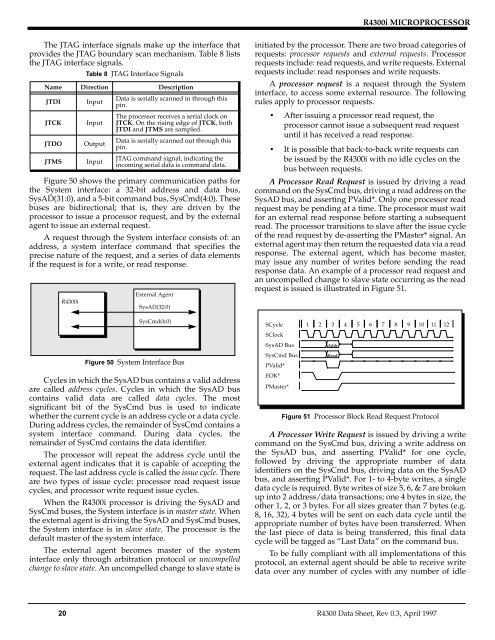R4300i Product Information - MIPS Technologies, Inc.
R4300i Product Information - MIPS Technologies, Inc.
R4300i Product Information - MIPS Technologies, Inc.
Create successful ePaper yourself
Turn your PDF publications into a flip-book with our unique Google optimized e-Paper software.
<strong>R4300i</strong> MICROPROCESSOR<br />
The JTAG interface signals make up the interface that<br />
provides the JTAG boundary scan mechanism. Table 8 lists<br />
the JTAG interface signals.<br />
Table 8 JTAG Interface Signals<br />
Name Direction Description<br />
JTDI<br />
JTCK<br />
JTDO<br />
JTMS<br />
Figure 50 shows the primary communication paths for<br />
the System interface: a 32-bit address and data bus,<br />
SysAD(31:0), and a 5-bit command bus, SysCmd(4:0). These<br />
buses are bidirectional; that is, they are driven by the<br />
processor to issue a processor request, and by the external<br />
agent to issue an external request.<br />
A request through the System interface consists of: an<br />
address, a system interface command that specifies the<br />
precise nature of the request, and a series of data elements<br />
if the request is for a write, or read response.<br />
<strong>R4300i</strong><br />
Input<br />
Input<br />
Output<br />
Input<br />
Data is serially scanned in through this<br />
pin.<br />
The processor receives a serial clock on<br />
JTCK. On the rising edge of JTCK, both<br />
JTDI and JTMS are sampled.<br />
Data is serially scanned out through this<br />
pin.<br />
JTAG command signal, indicating the<br />
incoming serial data is command data.<br />
External Agent<br />
SysAD(32:0)<br />
SysCmd(4:0)<br />
Figure 50 System Interface Bus<br />
Cycles in which the SysAD bus contains a valid address<br />
are called address cycles. Cycles in which the SysAD bus<br />
contains valid data are called data cycles. The most<br />
significant bit of the SysCmd bus is used to indicate<br />
whether the current cycle is an address cycle or a data cycle.<br />
During address cycles, the remainder of SysCmd contains a<br />
system interface command. During data cycles, the<br />
remainder of SysCmd contains the data identifier.<br />
The processor will repeat the address cycle until the<br />
external agent indicates that it is capable of accepting the<br />
request. The last address cycle is called the issue cycle. There<br />
are two types of issue cycle: processor read request issue<br />
cycles, and processor write request issue cycles.<br />
When the <strong>R4300i</strong> processor is driving the SysAD and<br />
SysCmd buses, the System interface is in master state. When<br />
the external agent is driving the SysAD and SysCmd buses,<br />
the System interface is in slave state. The processor is the<br />
default master of the system interface.<br />
The external agent becomes master of the system<br />
interface only through arbitration protocol or uncompelled<br />
change to slave state. An uncompelled change to slave state is<br />
initiated by the processor. There are two broad categories of<br />
requests: processor requests and external requests. Processor<br />
requests include: read requests, and write requests. External<br />
requests include: read responses and write requests.<br />
A processor request is a request through the System<br />
interface, to access some external resource. The following<br />
rules apply to processor requests.<br />
• After issuing a processor read request, the<br />
processor cannot issue a subsequent read request<br />
until it has received a read response.<br />
• It is possible that back-to-back write requests can<br />
be issued by the <strong>R4300i</strong> with no idle cycles on the<br />
bus between requests.<br />
A Processor Read Request is issued by driving a read<br />
command on the SysCmd bus, driving a read address on the<br />
SysAD bus, and asserting PValid*. Only one processor read<br />
request may be pending at a time. The processor must wait<br />
for an external read response before starting a subsequent<br />
read. The processor transitions to slave after the issue cycle<br />
of the read request by de-asserting the PMaster* signal. An<br />
external agent may then return the requested data via a read<br />
response. The external agent, which has become master,<br />
may issue any number of writes before sending the read<br />
response data. An example of a processor read request and<br />
an uncompelled change to slave state occurring as the read<br />
request is issued is illustrated in Figure 51.<br />
SCycle 1 2 3 4 5 6 7 8 9 10 11 12<br />
SClock<br />
SysAD Bus<br />
SysCmd Bus<br />
PValid*<br />
EOK*<br />
PMaster*<br />
Addr<br />
Read<br />
Figure 51 Processor Block Read Request Protocol<br />
A Processor Write Request is issued by driving a write<br />
command on the SysCmd bus, driving a write address on<br />
the SysAD bus, and asserting PValid* for one cycle,<br />
followed by driving the appropriate number of data<br />
identifiers on the SysCmd bus, driving data on the SysAD<br />
bus, and asserting PValid*. For 1- to 4-byte writes, a single<br />
data cycle is required. Byte writes of size 5, 6, & 7 are broken<br />
up into 2 address/data transactions; one 4 bytes in size, the<br />
other 1, 2, or 3 bytes. For all sizes greater than 7 bytes (e.g.<br />
8, 16, 32), 4 bytes will be sent on each data cycle until the<br />
appropriate number of bytes have been transferred. When<br />
the last piece of data is being transferred, this final data<br />
cycle will be tagged as “Last Data” on the command bus.<br />
To be fully compliant with all implementations of this<br />
protocol, an external agent should be able to receive write<br />
data over any number of cycles with any number of idle<br />
20 R4300 Data Sheet, Rev 0.3, April 1997

















